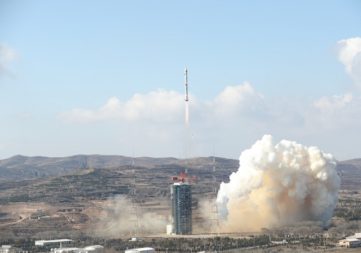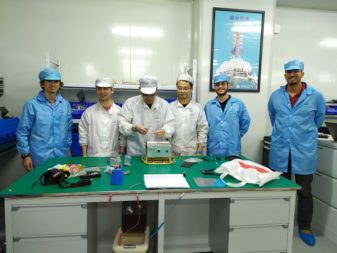26.11.2019

French propulsion startup ThrustMe unexpectedly made it into orbit early this month with its innovative propulsion system placed aboard a Chinese cubesat.
Dianfeng, or Xiaoxiang-1 (08), a six-unit cubesat developed by privately owned Spacety, was a secondary payload on the launch of the Gaofen-7 civilian Earth observation satellite Nov. 2, along with a first satellite for Sudan.
As with many Chinese launches, secondary payloads were not announced until after launch success was declared, but further surprises were aboard.
Along with small laser communications payloads for Chinese commercial companies, Dianfeng carries ThrustMe’s I2T5 non-pressurized, cold gas thruster fueled by solid iodine, which the company says is a first of its kind.

Designed for three- to six-unit cubesats, the 0.9-kilogram wet mass, low-thrust system allows a level of propulsion for collision avoidance, expanding time in orbit or assisting deorbiting as part of debris mitigation.
Founded in 2017, ThrustMe sought to commercialize iodine-based propulsion technology. It quickly developed a cold gas thruster and is working on an electric propulsion system for smallsats.
With an international team with expertise in fields such as space engineering, plasma physics, materials science, fluid dynamics, electronics and chemistry, ThrustMe has overcome challenges of dealing with corrosive iodine for space-based propulsion. The products can be shipped pre-filled and remain non-pressurized during launch.
The cooperation between the ThrustMe and Spacety developed rapidly, with a deal inked in February this year resulting in the early November launch.
“The speed and process of decision-making was quick and clear,” Ane Aanesland, joint founder and CEO of ThrustMe, told SpaceNews. “The execution of the project was very efficient.”
Aanesland said ThrustMe had received lots of interest from potential clients, but Spacety was willing to take the risk of employing an untested propulsion system.
Spacety, founded in 2016 and based in Changsha in central China, describes itself as specializing in low-cost, high-performance and reliable microsatellite platforms. The launch was the ninth the company has been involved in, with Dianfeng being the company’s 15th satellite in orbit.
It is working with partners including LaserFleet, a spinoff from the Chinese Academy of Sciences (CAS) that plans to build a low Earth orbit constellation providing broadband services through laser communications. Spacety quickly recognized the opportunities presented by ThrustMe.
Weijia Ren, co-founder and CTO of Spacety, said in a post-launch news release that the firm, “saw the potential for us in a long-term collaboration with ThrustMe so we can provide the best propulsion solutions to our clients in China.”
Notably, ThrustMe needed — and received — assistance from the French government and embassy to get the deal through fast. However, while cooperation developed quickly, there will be a wait before the parties can assess the performance of the system and chart deeper cooperation.
The first month of the mission will be dedicated to commissioning. After this, four other payloads, including two laser communications technology demonstrations and a multispectral imager, will be tested before the I2T5 thruster. This means it will be between two-to-six months before the results come in.
Spacety said it was unable to comment before testing of the propulsion system. But Aanesland says both companies have expressed keen interest in furthering cooperation. And while talks with other Chinese firms have taken place, Spacety stood out.
Tianyi Lan, founder of Ultimate Blue Nebula Co., Ltd.,a Beijing-based space consulting company, told SpaceNews that more such deals between European and Chinese firms can be expected.
“Compared with U.S. export policies and regulations, [the] European space environment is better … The [biggest] barrier should be the ITAR-like regulations, but more and more European companies are developing ITAR-free components or devices to meet the regulations,” Lan says.
Lan notes that Surrey Satellite Technology Ltd, GomSpace, ISIS and Thales Alenia Space have all previously developed good partnerships with Chinese space companies.

He also underlines that the space industry is very much international, with “everyone looking for more business benefits from the international market.”
“We believe that new companies like ThrustMe will gain more market in China, and China’s new space companies will create new cooperation opportunities with EU companies, based on flexible launch rates and price, manufacturing costs, and a huge market,” Lan said.
Aanesland says China has not yet truly fostered a culture of innovation, presenting opportunities for European companies and win-win cooperation, but that window may soon close.
“I find it extremely fascinating what is happening in China. If you look at R&D development and how quickly they work, if we don’t start working with China now, we’ll be left on the sidelines.”
ThrustMe will see a demo of its NPT30 miniaturized electric propulsion system on the GomSpace GOMX-5 ESA mission, to launch in 2021. Spacety’s next mission could come as soon as late November, and is also developing larger satellite platforms.
Quelle: SN
